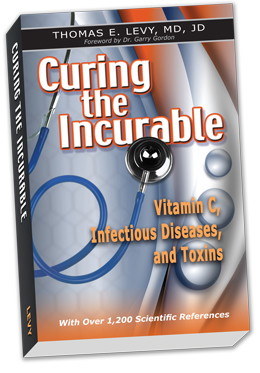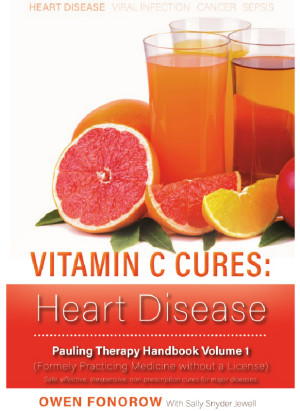Vitamin C Prevents Vaccination Side Effects; Increases Effectiveness
“Unlike virtually all prescription drugs and some supplements, vitamin C has never been found to have any dosage level above which it can be expected to demonstrate any toxicity.”

by Thomas E Levy, MD, JD
(OMNS, Feb 14, 2012) The routine administration of vaccinations continues to be a subject of controversy in the United States, as well as throughout the world. Parents who want the best for their babies and children continue to be faced with decisions that they fear could harm their children if made incorrectly. The controversy over the potential harm of vaccinating, or of not vaccinating, will not be resolved to the satisfaction of all parties anytime soon, if ever. This brief report aims to offer some practical information to pediatricians and parents alike who want the best long-term health for their patients and children, regardless of their sentiments on the topic of vaccination in general.
While there seems to be a great deal of controversy over how frequently a vaccination might result in a negative outcome, there is little controversy that at least some of the time vaccines do cause damage. The question that then emerges is whether something can be done to minimize, if not eliminate, the infliction of such damage, however infrequently it may occur.
Causes of Vaccination Side Effects
When vaccines do have side effects and adverse reactions, these outcomes are often categorized as resulting from allergic reactions or the result of a negative interaction with compromised immune systems.
While either type of reaction can be avoided subsequently (when there is a history of a bad reaction having occurred at least once in the past as a result of a vaccination) by not giving the injections to the patient. For first time vaccine administration, it is vital to try to avoid encountering a negative outcome.
Due to the fact that all toxins, toxic effects, substantial allergic reactions, and induced immune compromise have the final common denominator of causing and/or resulting in the oxidation of vital biomolecules, the antioxidant vitamin C has proven to be the ultimate nonspecific antidote to whatever toxin or excess oxidative stress might be present.
While there is also a great deal of dispute over the inherent toxicity of the antigens that many vaccines present to the immune systems of those vaccinated, there is no question, for example, that thimerosal, a mercury-containing preservative, is highly toxic when present in significant amounts. This then begs the question: Rather than argue whether there is an infinitesimal, minimal, moderate, or significant amount of toxicity associated with the amounts of thimerosal or other potentially toxic components presently being used in vaccines, why not just neutralize whatever toxicity is present as completely and definitively as possible?
Vitamin C is a Potent Antitoxin
In addition to its general antitoxin properties (Levy, 2002), vitamin C has been demonstrated to be highly effective in neutralizing the toxic nature of mercury in all of its chemical forms. In animal studies, vitamin C can prevent the death of animals given otherwise fatal doses of mercury chloride (Mokranjac and Petrovic, 1964). Having vitamin C on board prior to mercury exposure was able to prevent the kidney damage the mercury otherwise typically caused (Carroll et al., 1965). Vitamin C also blocked the fatal effect of mercury cyanide (Vauthey, 1951). Even the very highly toxic organic forms of mercury have been shown to be effectively detoxified by vitamin C (Gage, 1975).
Vitamin C Improves Vaccine Effectiveness
By potential toxicity considerations alone, then, there would seem to be no good reason not to pre- and post-medicate an infant or child with some amount of vitamin C to minimize or block the toxicity that might significantly affect a few. However, there is another compelling reason to make vitamin C an integral part of any vaccination protocol: Vitamin C has been documented to augment the antibody response of the immune system (Prinz et al., 1977; Vallance, 1977; Prinz et al., 1980; Feigen et al., 1982; Li and Lovell, 1985; Amakye-Anim et al., 2000; Wu et al., 2000; Lauridsen and Jensen, 2005; Azad et al., 2007). As the goal of any vaccination is to stimulate a maximal antibody response to the antigens of the vaccine while causing minimal to no toxic damage to the most sensitive of vaccine recipients, there would appear to be no medically sound reason not to make vitamin C a part of all vaccination protocols.
Except in individuals with established, significant renal insufficiency, vitamin C is arguably the safest of all nutrients that can be given, especially in the amounts discussed below. Unlike virtually all prescription drugs and some supplements, vitamin C has never been found to have any dosage level above which it can be expected to demonstrate any toxicity.
Vitamin C Reduces Mortality in Vaccinated Infants and Children
Kalokerinos (1974) demonstrated repeatedly and quite conclusively that Aboriginal infants and children, a group with an unusually high death rate after vaccinations, were almost completely protected from this outcome by dosing them with vitamin C before and after vaccinations. The reason articulated for the high death rate was the exceptionally poor and near-scurvy-inducing (vitamin C-depleted) diet that was common in the Aboriginal culture. This also demonstrates that with the better nutrition in the United States and elsewhere in the world, the suggested doses of vitamin C should give an absolute protection against death (essentially a toxin-induced acute scurvy) and almost absolute protection against lesser toxic outcomes from any vaccinations administered. Certainly, there appears to be no logical reason not to give a nontoxic substance known to neutralize toxicity and stimulate antibody production, which is the whole point of vaccine administration.
Dosage Information for Pediatricians and Parents
Practically speaking, then, how should the pediatrician or parent proceed? For optimal antibody stimulation and toxin protection, it would be best to dose for three to five days before the shot(s) and to continue for at least two to three days following the shot. When dealing with infants and very young children, administering a 1,000 mg dose of liposome-encapsulated vitamin C would be both easiest and best, as the gel-like nature of this form of vitamin C allows a ready mixture into yogurt or any other palatable food, and the complete proximal absorption of the liposomes would avoid any possible loose stools or other possible undesirable bowel effects.
Vitamin C as sodium ascorbate powder will also work well. Infants under 10 pounds can take 500 mg daily in some fruit juice, while babies between 10 and 20 pounds could take anywhere from 500 mg to 1,000 mg total per day, in divided doses.
Older children can take 1,000 mg daily per year of life (5,000 mg for a 5 year-old child, for example, in divided doses). If sodium must be avoided, calcium ascorbate is well-tolerated and, like sodium ascorbate, is non-acidic. Some but not all children’s chewable vitamins are made with calcium ascorbate. Be sure to read the label.
Giving vitamin C in divided doses, all through the day, improves absorption and improves tolerance. As children get older, they can more easily handle the ascorbic acid form of vitamin C, especially if given with meals. For any child showing significant bowel sensitivity, (e.g., gas or diarrhea) I recommend either using liposome-encapsulated vitamin C, or the reducing the amount of regular vitamin C to an easily tolerated amount.
Very similar considerations exist for older individuals receiving any of a number of vaccinations for preventing infection, such as the yearly flu shots. When there is really no urgency, and there rarely is, such individuals should supplement with vitamin C for several weeks before and several weeks after, if at all possible.
Even taking a one-time dose of vitamin C in the dosage range suggested above directly before the injections can still have a significant toxin-neutralizing and antibody-stimulating effect.
The likelihood of having a positive outcome results improves from extending the pre- and post-dosing periods of time.
(Thomas Levy, MD, JD is a board-certified cardiologist and admitted to the bar in Colorado and the District of Colombia. He is the author of several books on vitamin C as well as numerous articles. By way of disclaimer, he is a consultant to a company that sells a brand of liposome-encapsulated vitamin C. A vitamin C lecture by Dr. Levy may be viewed at:
http://www.youtube.com/watch?v=k0GC9Fq8lfg
References:
Amakye-Anim, J., T. Lin, P. Hester, et al. (2000) Ascorbic acid supplementation improved antibody response to infectious bursal disease vaccination in chickens. Poultry Science 79:680-688
Azad, I., J. Dayal, M. Poornima, and S. Ali (2007) Supra dietary levels of vitamins C and E enhance antibody production and immune memory in juvenile milkfish, Chanos chanos (Forsskal) to formalin-killed Vibrio vulnificus. Fish & Shellfish Immunology 23:154-163
Carroll, R., K. Kovacs, and E. Tapp (1965) Protection against mercuric chloride poisoning of the rat kidney. Arzneimittelforschung 15:1361-1363
Feigen, G., B. Smith, C. Dix, et al. (1982) Enhancement of antibody production and protection against systemic anaphylaxis by large doses of vitamin C. Research Communications in Chemical Pathology and Pharmacology 38:313-333
Gage, J. (1975) Mechanisms for the biodegradation of organic mercury compounds: the actions of ascorbate and of soluble proteins. Toxicology and Applied Pharmacology 32:225-238
Kalokerinos, A. (1974) Every Second Child. New Canaan, CT: Keats Publishing, Inc.
Lauridsen, C. and S. Jensen (2005) Influence of supplementation of all-rac-alpha-tocopheryl acetate preweaning and vitamin C postweaning on alpha-tocopherol and immune responses in piglets. Journal of Animal Science 83:1274-1286
Levy, T. (2004) Curing the Incurable. Vitamin C, Infectious Diseases, and Toxins. Henderson, NV: MedFox Publishing
Li, Y. and R. Lovell (1985) Elevated levels of dietary ascorbic acid increase immune responses in channel catfish. The Journal of Nutrition 115:123-131
Mokranjac, M. and C. Petrovic (1964) Vitamin C as an antidote in poisoning by fatal doses of mercury. Comptes Rendus Hebdomadaires des Seances de l’Academie des Sciences 258:1341-1342
Prinz, W., R. Bortz, B. Bregin, and M. Hersch (1977) The effect of ascorbic acid supplementation on some parameters of the human immunological defence system. International Journal for Vitamin and Nutrition Research 47:2248-257
Prinz, W., J. Bloch, G., G. Gilich, and G. Mitchell (1980) A systematic study of the effect of vitamin C supplementation on the humoral immune response in ascorbate-dependent mammals. I. The antibody response to sheep red blood cells (a T-dependent antigen) in guinea pigs. International Journal for Vitamin and Nutrition Research 50:294-300
Vallance, S. (1977) Relationships between ascorbic acid and serum proteins of the immune system. British Medical Journal 2:437-438
Vauthey, M. (1951) Protective effect of vitamin C against poisons. Praxis (Bern) 40:284-286
Wu, C., T. Dorairajan, and T. Lin (2000) Effect of ascorbic acid supplementation on the immune response of chickens vaccinated and challenged with infectious bursal disease virus. Veterinary Immunology and Immunopathology 74:145-152
Nutritional Medicine is Orthomolecular Medicine
Orthomolecular medicine uses safe, effective nutritional therapy to fight illness. For more information: http://www.orthomolecular.org
Find a Doctor
To locate an orthomolecular physician near you: http://orthomolecular.org/resources/omns/v06n09.shtml
The peer-reviewed Orthomolecular Medicine News Service is a non-profit and non-commercial informational resource.



1 Response
Misconceptions and Facts: Lies and Truth About the Business of Modeling
The truth of the web business market is greater than it appears to be. Let’s see it?